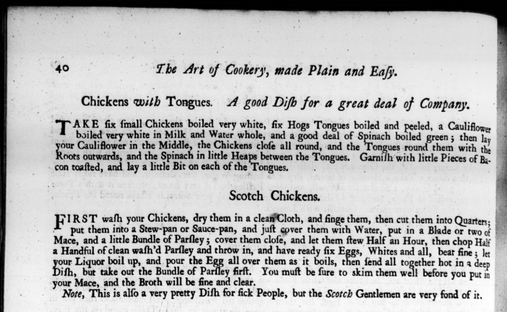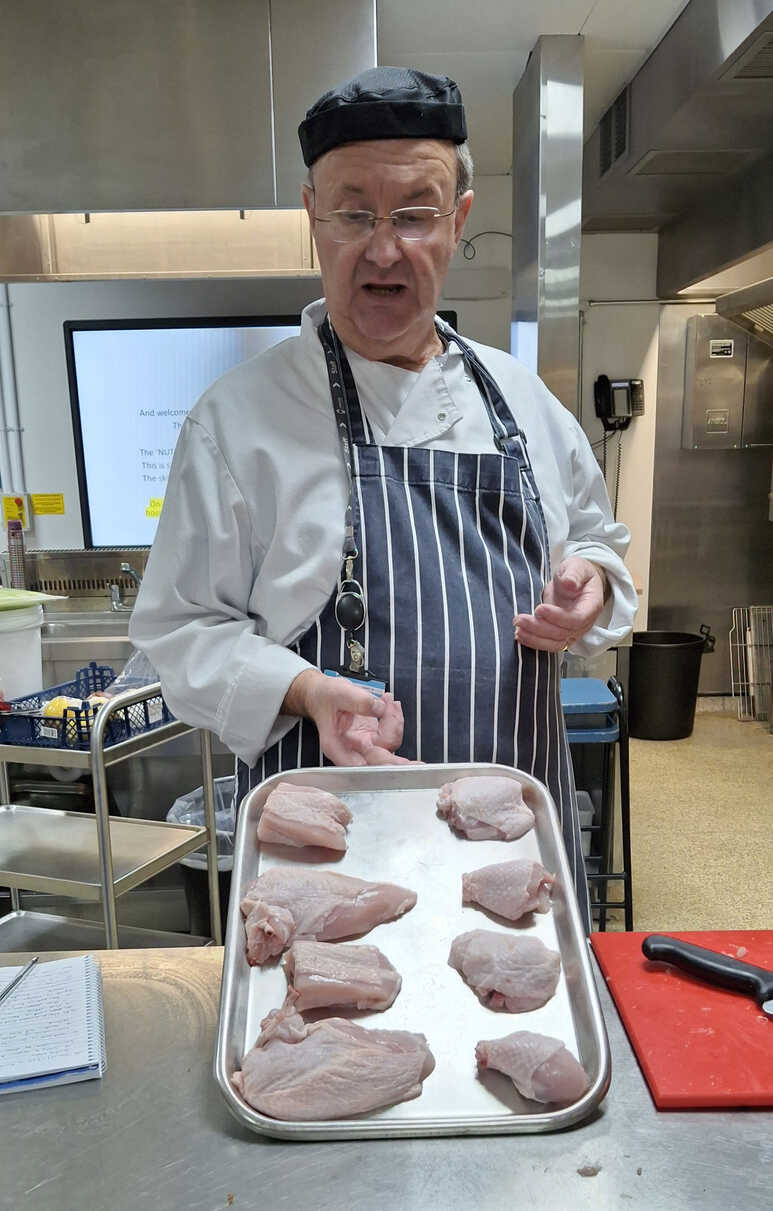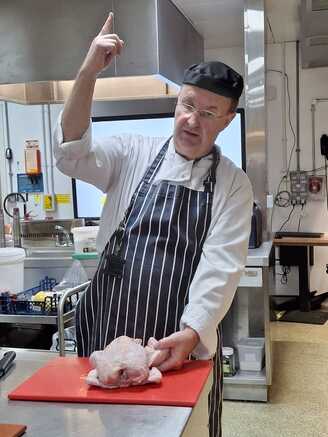Street Food 3 - Southern Fried Chicken
So what is it about Fried Chicken that makes it Southern?
The answer, my friend, is blowing in the tornado.
Though it definitely involves marinating the chicken in buttermilk. Of which the class had none 😢
However I'd like to extend my sympathy to Teacher Paul, who's dealing with family illnesses at the moment and so might not be bringing the class his A game.
Or his buttermilk.
The answer, my friend, is blowing in the tornado.
Though it definitely involves marinating the chicken in buttermilk. Of which the class had none 😢
However I'd like to extend my sympathy to Teacher Paul, who's dealing with family illnesses at the moment and so might not be bringing the class his A game.
Or his buttermilk.
The Southern aspect of Southern Fried Chicken is, of course, the Southern states of the United States - particularly Alabama, Georgia, Tennessee, Virginia, the Carolinas and perhaps most famously, Kentucky.
This is characterised by chicken joints marinated in buttermilk before being dredged with seasoned flour and shallow or deep-fried.
Any investigation of the origins of this form of chicken will inevitably yield two supposed sources - Africa and Scotland.
The claim will be made that Scots are famous deep fat fryers who influenced the cuisine of the Southern states to which they emigrated. The trouble is that whilst Scots are indeed notoriously fry-happy, even going so far as to batter and fry Mars bars, this is the modern Scot. The Scots of yesteryear who migrated to America in the mid 1700s were famous for boiling everything: Porridge. Turnips. Haggis. They almost certainly didn't even have access to the quantities of fat required to deep-fry all their food off in the barren Northern wastelands of the pre-Enlightened Scottish Highlands.
All of the Scotch recipes in the oft-referenced 1747 The Art of Cookery Made Plain and Easy, including one for Scotch Chickens, involve only boiling or shallow-frying in butter.
Moreover, the insular Scots (and the Irish) mostly settled up in the mountains as far away as possible from everyone else, and a long way from the coastal and tidewater lowlands where fried chicken was already being developed before they'd even arrived.
Back home, however, those Africans shipped across the Atlantic as slaves, would have had use of coconut oil, olive oil, peanut oil, sesame oil, palm oil, and hair oil in their cooking. OK, perhaps not the hair oil.
Heavy seasonings, battered fritters and deep-fat frying in general are now and probably were then widespread throughout West Africa.
It seems most likely to me that Southern Fried Chicken has more African roots than Scottish.
Teacher Paul demonstrated a new (to me) and exciting chicken jointing technique in which the breasts are cut in half along the length of the chicken while still attached to the skeleton. À la KFC!
Here is the process, which yields eight portions conveniently dividing equally between white and dark pieces - two breasts, two supremes, two thighs and two drumsticks:
Any investigation of the origins of this form of chicken will inevitably yield two supposed sources - Africa and Scotland.
The claim will be made that Scots are famous deep fat fryers who influenced the cuisine of the Southern states to which they emigrated. The trouble is that whilst Scots are indeed notoriously fry-happy, even going so far as to batter and fry Mars bars, this is the modern Scot. The Scots of yesteryear who migrated to America in the mid 1700s were famous for boiling everything: Porridge. Turnips. Haggis. They almost certainly didn't even have access to the quantities of fat required to deep-fry all their food off in the barren Northern wastelands of the pre-Enlightened Scottish Highlands.
All of the Scotch recipes in the oft-referenced 1747 The Art of Cookery Made Plain and Easy, including one for Scotch Chickens, involve only boiling or shallow-frying in butter.
Moreover, the insular Scots (and the Irish) mostly settled up in the mountains as far away as possible from everyone else, and a long way from the coastal and tidewater lowlands where fried chicken was already being developed before they'd even arrived.
Back home, however, those Africans shipped across the Atlantic as slaves, would have had use of coconut oil, olive oil, peanut oil, sesame oil, palm oil, and hair oil in their cooking. OK, perhaps not the hair oil.
Heavy seasonings, battered fritters and deep-fat frying in general are now and probably were then widespread throughout West Africa.
It seems most likely to me that Southern Fried Chicken has more African roots than Scottish.
Teacher Paul demonstrated a new (to me) and exciting chicken jointing technique in which the breasts are cut in half along the length of the chicken while still attached to the skeleton. À la KFC!
Here is the process, which yields eight portions conveniently dividing equally between white and dark pieces - two breasts, two supremes, two thighs and two drumsticks:
- Remove the wishbone and free the oysters.
These are optional steps - cut around the triangular V of the wishbone to more easily pull it out, and with the chicken breast-side down cut across the oysters at the top of the thigh so they will remain attached to the leg joints when they are removed.
- With the chicken breast-side up, cut around the base of the leg, force open the joint with the chicken's hips and cut the leg free.
- Separate the thigh from the drumstick by cutting through the knee joint.
- With the chicken breast-side up, neck towards you, place the first joint of your thumb on the chicken's breast-bone and holding the skin taut, cut lengthways down through the breast at the tip of your thumb.
This will release a half-breast supreme with the wings still attached. - Remove the two end wing bones, cutting at the second joint to leave only the first bone attached to the breast.
- Repeat on the other side.
- With the carcass standing neck downmost, chop quickly down close along the breastbone to separate the ribs. Continue cutting to release the entire breastbone with two half-breasts still attached on either side.
- Cut across the breastbone to create two bone-in breast pieces.
Teacher Paul then proceeded to show us how to finish the chicken pieces in the manner of a professional kitchen by removing the joint ends from the protruding bones with a sharp blow to the back of the knife,
pulling out all dangling sinews, (an awkward and messy process) and scraping back the flesh from the bone ends to neaten them up.
Paul referred to this latter process as chining, but I fear he may be confused:
Rib-roasts of meat, especially beef but also lamb, are often served with the backbone (known as the chine) separated from the ribs to make carving easier. This is called chining.
Scraping back the flesh and sinew from the ends of bones to give them a cleaner, whiter look, particular when roasting, is called Frenching.
This week's PaulPointers™
Paul referred to this latter process as chining, but I fear he may be confused:
Rib-roasts of meat, especially beef but also lamb, are often served with the backbone (known as the chine) separated from the ribs to make carving easier. This is called chining.
Scraping back the flesh and sinew from the ends of bones to give them a cleaner, whiter look, particular when roasting, is called Frenching.
This week's PaulPointers™
- Dress coleslaw with a vinaigrette before adding mayonnaise for extra zing.
- Supermarkets are evil masters, and force their suppliers to dance to their arbitrary tunes. Even to the point of wasting perfectly good produce if it doesn't meet their standards.
- Now is the best time to buy Spring Lamb, paradoxically. Actually born in the spring, they've only now had time to graze in the pastures and put a bit of meat on.
- Paul is not a big fan of cheese graters except perhaps for cheese. You should shred your coleslaw ingredients with a knife, like an axe murderer. Or, well, a knife murderer.
menu
Southern
Fried Chicken
Fried Chicken
It's finger lickin' reasonable.
Coleslaw
What would Southern chicken be without a pile of slimy mattress on which to serve it?
Karl's Southern Fried Chicken
main fowl
Since the class had no marinade nor an extensive collection of spices with which to season the flour, I invented my own Southern-Style fried chicken later at home.
Karl's Fried Chicken. Conveniently abbreviated to KFC. How catchy!
It's still not as good as the real KFC 🙁
The secret of which, by the way, may well be in their pressurised deep-fat-frying. But don't try that at home kids!
Since I too had no buttermilk, I decided to try brining my chicken pieces for 24 hours. I must say it seemed to produce very juicy flesh.
If there was a problem it was with the coating, which as a bit claggy, didn't adhere well enough to the chicken, and was over-salted.
Which might be a condemnation of both my experimental mayonnaise wet bath loosened with milk, and my over-seasoned flour.
Pity, I had high hopes of the mayonnaise-bathing. More delicious experimentation may be required.
Remember kids, in Teacher Paul's classes there are no quantities...
Karl's Fried Chicken. Conveniently abbreviated to KFC. How catchy!
It's still not as good as the real KFC 🙁
The secret of which, by the way, may well be in their pressurised deep-fat-frying. But don't try that at home kids!
Since I too had no buttermilk, I decided to try brining my chicken pieces for 24 hours. I must say it seemed to produce very juicy flesh.
If there was a problem it was with the coating, which as a bit claggy, didn't adhere well enough to the chicken, and was over-salted.
Which might be a condemnation of both my experimental mayonnaise wet bath loosened with milk, and my over-seasoned flour.
Pity, I had high hopes of the mayonnaise-bathing. More delicious experimentation may be required.
Remember kids, in Teacher Paul's classes there are no quantities...
Serves 4 people Two light and Two dark pieces
Ingredients
- pieces from 1 chicken - skin on, bone in
- milk
- mayonnaise
- oil for deep-frying
For the Brine:- ¼ cup salt
- 1 litre water
- 2 tablespoons sugar
- ½ lemon
For the Seasoned Flour:- self-raising flour
- cornflour
- garlic salt
- onion salt
- ground white pepper
- smoked paprika
- dried mint
- dried parsley
- mixed dried herbs: marjoram, thyme, basil, oregano
- cumin powder
To make the brine, slice the zest from half a lemon and put into a bowl with the salt and sugar.
Add just the boiling water required to dissolve the crystals with a bit of stirring. Top up to the necessary volume with ice water.
Add the chicken pieces, swirl them around, cover and set in the fridge for at least a few hours, but preferably overnight or for up to a day.
Spoon the mayonnaise in a bowl and whisk with just enough milk or buttermilk! to make a coating liquid that drips off the spoon. Mix the herbs and spices of your choice with self-raising flour blended with about one quarter cornflour for added crispness.
Remove the chicken pieces from the brine and dry thoroughly on kitchen roll.
Dip each chicken piece in the mayonnaise mixture, shake off excess, and roll thoroughly in the seasoned flour.
Shake off the excess and line them up on a tray.
Remove the pieces from the oven when their centres reach 74°C for dark meat and 65°C for the breast.
Add just the boiling water required to dissolve the crystals with a bit of stirring. Top up to the necessary volume with ice water.
Add the chicken pieces, swirl them around, cover and set in the fridge for at least a few hours, but preferably overnight or for up to a day.
Spoon the mayonnaise in a bowl and whisk with just enough milk or buttermilk! to make a coating liquid that drips off the spoon. Mix the herbs and spices of your choice with self-raising flour blended with about one quarter cornflour for added crispness.
I list the herbs-n-spices I used above for reference but they were mostly just the things I had in the cupboard.
The result was much too salty. Particularly since the chicken is already well salted from the brine.
I'd recommend keeping some herbs, the white pepper and the paprika and I'd be inclined to add some MSG if I try it again.
Heat a deep-fryer to 200°C the target cooking temperature is going to be about 170°C and the oven to 180°C/350°F/Gas Mark 4.
Arrange a wire rack over an oven tin.Remove the chicken pieces from the brine and dry thoroughly on kitchen roll.
Dip each chicken piece in the mayonnaise mixture, shake off excess, and roll thoroughly in the seasoned flour.
Shake off the excess and line them up on a tray.
Probably I should have tried dipping flour, then mayonnaise mix, then flour again to get better adhesion.
When all are ready, fry without overcrowding in batches for about 10 minutes until they turn golden brown and crispy, then put them on the wire rack in the oven to finish while frying the rest.
Re-heat the oil to 200°C between batches.Remove the pieces from the oven when their centres reach 74°C for dark meat and 65°C for the breast.
Frying in oil at 170°C, whilst ideal for crispness, may not be long enough to properly cook the chicken through without burning the coating. A bit of time spent in the oven will sort that out.
Otherwise you may have to reduce the temperature of your oil.
At this stage you can chow down immediately like a caveman, or cool and refrigerate the cooked chicken then re-fry just before serving for an extra-crispy result.
Otherwise you may have to reduce the temperature of your oil.
Truth be told, it's hard to go wrong with chickens' bits deep-fried in fat.
As long as you don't over-salt them 🙄
Coleslaw
salad veg
This coleslaw was described by Teacher Paul as fruity and spicy.
No mention of slimy though.
One can find many desperate attempts documented online at making coleslaw edible, even palatable, all with equally dismal results in my opinion:
Frankly I think your time might be better spent plucking your nose hairs. Which are probably equally delicious.
No mention of slimy though.
One can find many desperate attempts documented online at making coleslaw edible, even palatable, all with equally dismal results in my opinion:
- Kenji of Serious Eats salts his vegetables aggressively, then rinses and dries them thoroughly.
It is his opinion that raw cabbage is too crunchy and watery and requires tenderizing.
- Nigel Slater suggests soaking the cabbage in cold water for 20 minutes.
It is his opinion that cabbage au naturel is not crunchy enough!
- Felicity Cloake
passes along a recommendation for marinating the cabbage in salted vinegar water for an hour to improve its tanginess
- Jazzing up the dressing with sour cream, buttermilk, black pepper, celery seeds, mustard, vinegar, horseradish.
- Adding novelty sliced vegetables like mouli, celeriac, kohlrabi.
- Attempting to rouse interest with the addition of nuts, seeds, grated cheese, apples, raisins, capers, parsley.
Frankly I think your time might be better spent plucking your nose hairs. Which are probably equally delicious.
Serves No-one Well
Ingredients
- salt
- red cabbage
- green cabbage
- orange carrot
- yellow onion
- red onion
- red chilli optional
- golden sultanas optional
Dressing:- mayonnaise
Slice all the vegetables super-thinly.
Add in some chilli slices if you like it spicy, and a few sultanas if you like it fruity.
Add in some chilli slices if you like it spicy, and a few sultanas if you like it fruity.
Don't overdo the sultanas - you can have too much fruit.
I halved mine lengthways to improve the mouthfeel.
Salt pretty generously, mix well with a dollop of mayonnaise.
I halved mine lengthways to improve the mouthfeel.
Adding a splash of buttermilk to the dressing seems like an appropriate addition for pairing with Southern Fried Chicken.




